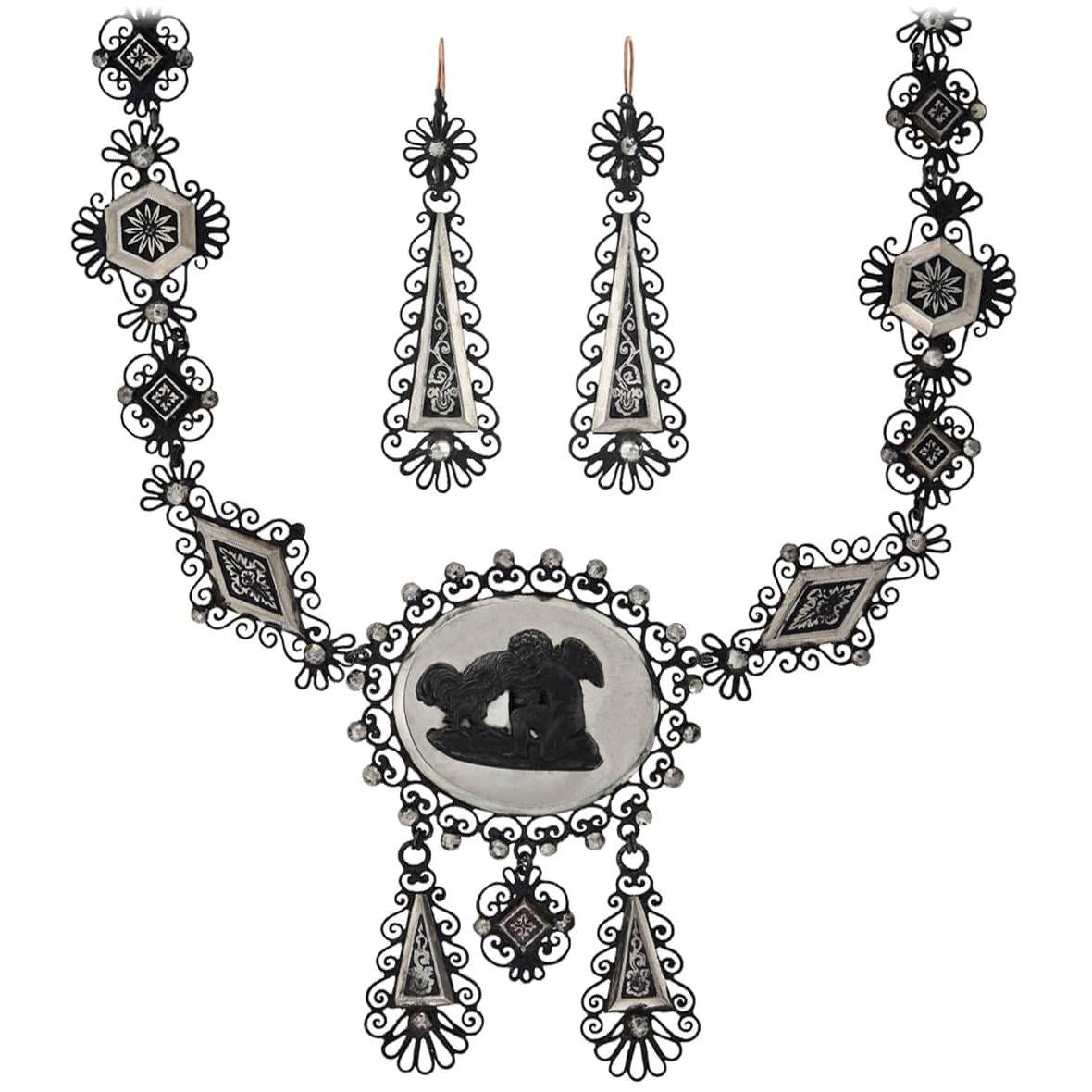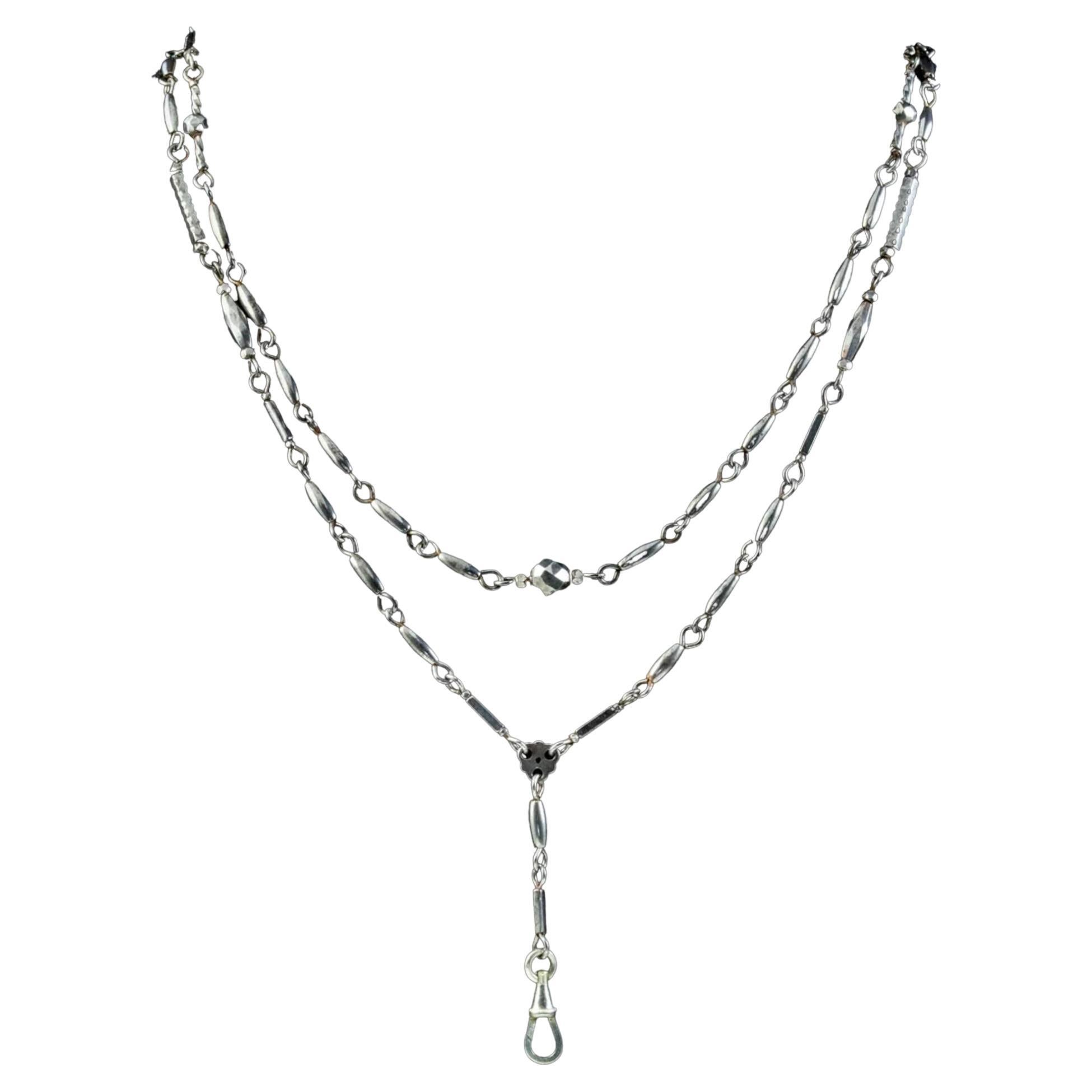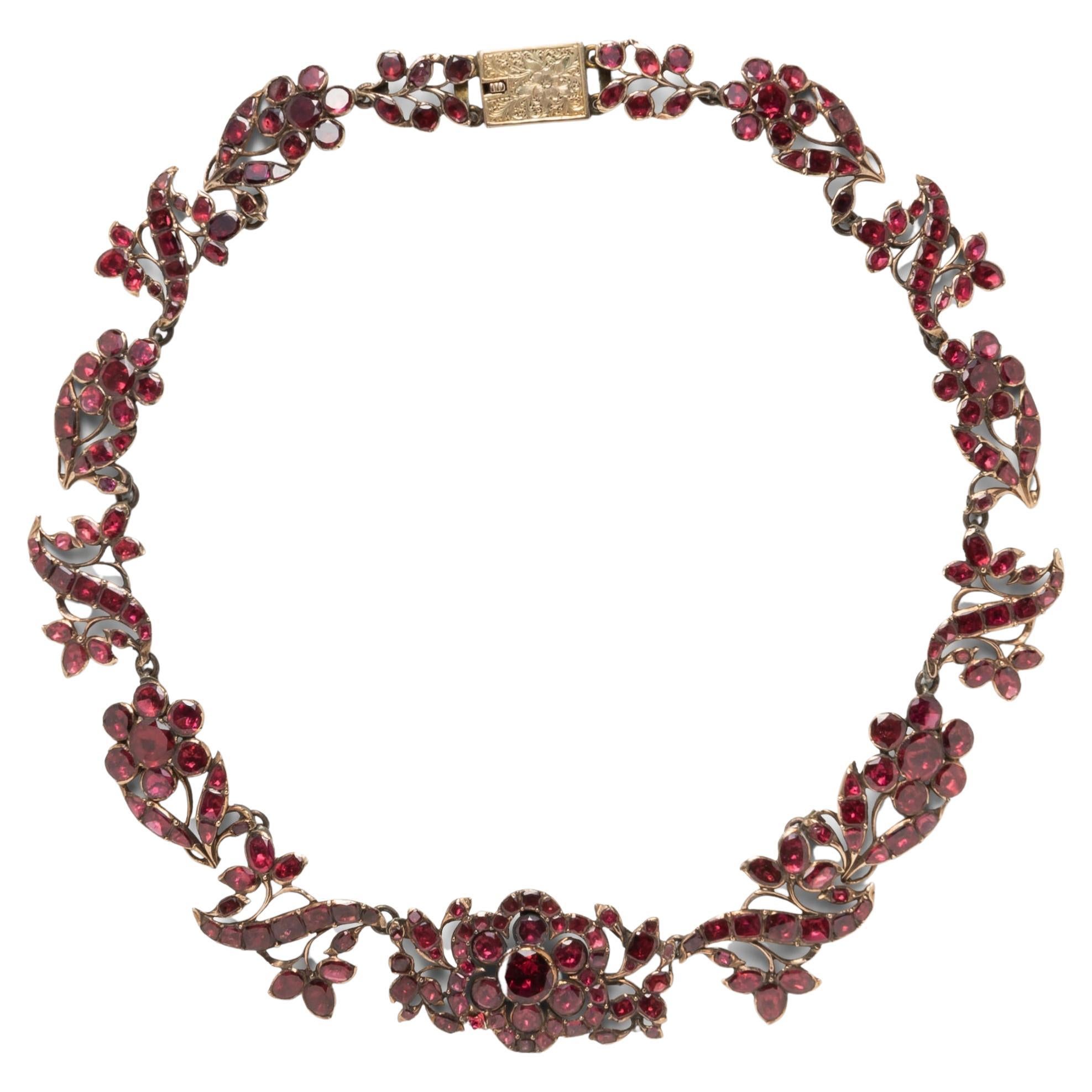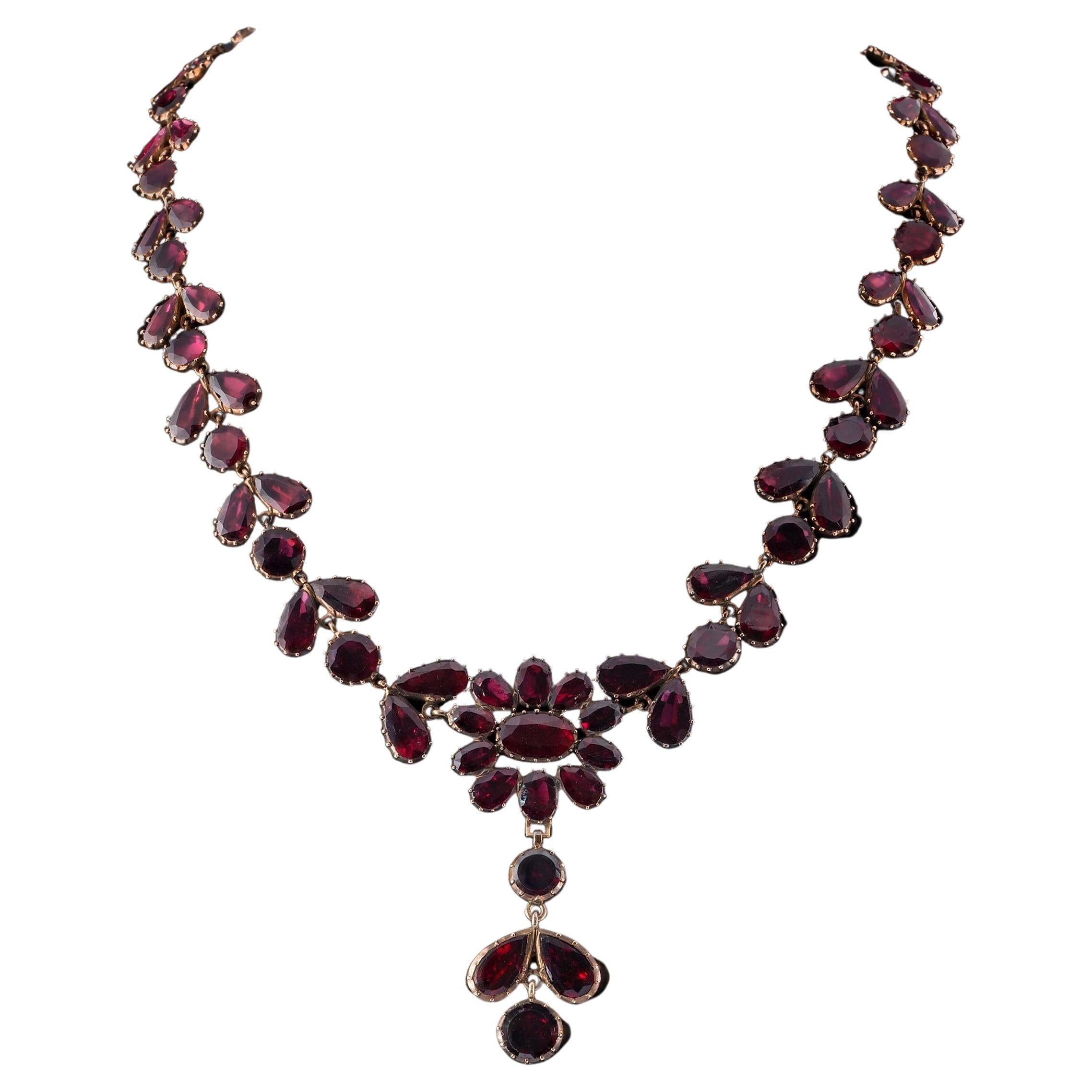Items Similar to Antique Georgian1820s Early Cut Steel Necklace
Want more images or videos?
Request additional images or videos from the seller
1 of 6
Antique Georgian1820s Early Cut Steel Necklace
About the Item
A crowning glory of design, this cut steel necklace shimmers like diamonds, in available light as it did originally in the early 1800's. Serves dressy occasions or denim shirts and blue jeans by bringing a unique sense of style with its varied cuts of steel, swirls on the center plaque and to the sides of the center. You can easily see the design but not the romantic glimmer as photos can do just so much. Silver haired ladies, and brunettes are thrilled with cut steel jewelry which enhances the beauty of both.
Cut steel is completely hand designed and made in the early years before electricity made life easier. Only the early pieces contained many shapes and sizes of steel "diamonds". The painstaking hand work was appreciated from first sight and cut steel was immediately in demand and valued highly. This necklace is in excellent condition.
- Creator:Glorious Antique Jewe;ry
- Metal:
- Style:George IV
- Place of Origin:
- Period:Early 18th Century
- Date of Manufacture:c1830
- Condition:
- Seller Location:Stamford, CT
- Reference Number:
About the Seller
5.0
Recognized Seller
These prestigious sellers are industry leaders and represent the highest echelon for item quality and design.
Gold Seller
These expertly vetted sellers are highly rated and consistently exceed customer expectations.
Established in 1986
1stDibs seller since 2009
315 sales on 1stDibs
Typical response time: 1 hour
- ShippingRetrieving quote...Ships From: Stamford, CT
- Return PolicyA return for this item may be initiated within 3 days of delivery.
More From This SellerView All
- Georgian Cut Steel Long Earrings.Located in Stamford, CTCrescent moons, dragon flies and diamond forms make these earrings a geometric delight. They sparkle even with low light at night. All bits of steel were cut and polished by hand the...Category
Antique Early 19th Century British George III Chandelier Earrings
MaterialsCut Steel
- Georgian Varied Cut Steel BroochLocated in Stamford, CTThis Cut Steel brooch has telltale Georgian characteristics. Georgian era cut steel has a variety of cut steel bits held in place by rivets to the back brass plaque that has first be...Category
Antique 1820s English George III Brooches
MaterialsCut Steel
- Pair of Handmade Georgian Cut Steel BraceletsBy Glorious Antique Jewelry CollectionLocated in Stamford, CTTwo are better than one when you find a rare pair of cut steel bracelets made of tightly clustered cut steel rivets that form flowers and bows along th...Category
Antique Early 19th Century British George IV Link Bracelets
MaterialsCut Steel
- Early Victorian Cut Steel Pave Hair CombLocated in Stamford, CTImagine this Early Victorian Cut Steel Hair in your hair, highlighting its natural beauty. The little bells move but do not jangle. Each cut steel ...Category
Antique 1840s British Early Victorian More Jewelry
MaterialsSteel, Cut Steel
- Rare Georgian Romantic Pendant and Earrings in Cut SteelBy Glorious Antique Jewelry CollectionLocated in Stamford, CTA rare cut steel and porcelain pendant and earrings in the striking design of bullets and bows with rose cut steel sparkles was made in the early 19th c...Category
Antique 1830s British George V Chandelier Earrings
MaterialsCut Steel
- Antique Victorian Turquoise Glass and Cut Steel Earrings, c. 1840Located in Stamford, CTBlue glass chandelier navettes surrounded by cut steel are unusual and though they originate from c.1840’s they have contemporary cheer.The beautiful blue brightens the face and eyes...Category
Antique 1620s British Georgian Chandelier Earrings
MaterialsCut Steel
You May Also Like
- Georgian Berlin Iron and Mirrored Cut Steel Necklace and Earring SetLocated in Narberth, PABerlin iron jewelry was produced in Germany by the Berlin Royal Foundry beginning in 1804. Previously, iron jewelry had been worn primarily during periods of mourning due to the dark color of its black lacquer finish. However, it reached a high point of popularity between 1813 and 1830. To fund the War of Liberation against Napolean, citizens were asked to donate their precious gold in exchange for iron jewelry. The Berlin iron jewelry was sometimes inscribed with a portrait of Frederick William III of Prussia, or with the words "Gold gab ich für Eisen" (meaning "I gave gold for iron") or "Für das Wohl des Vaterlands" ("For the welfare of our country/fatherland"). Almost overnight, Berlin iron jewelry became a symbol of patriotism. Its beautiful fabrication and lacy appearance gave it widespread appeal, eventually reaching popularity in numerous European countries. Authentic Berlin iron jewelry is now very rare, and well-preserved pieces have become very collectible! Cut steel jewelry originated in England in the 17th century and subsequently spread throughout Europe, eventually becoming a popular style of jewelry worn by members of high society during the Victorian era. Made of polished faceted steel studs, the pieces were cut by hand and then assembled and riveted onto a metal back. The faceted steel elements give this type of jewelry a subtle, metallic glitter that resembles cut gemstones. Motifs varied from the simple to the sublime, with multiple layers and densely packed studs. The time-consuming process and the artistry required to create cut steel jewelry made it very valuable and highly sought-after during the Victorian age, particularly to wear during the stage of "secondary mourning." Produced up until the turn of the 19th century, antique cut steel jewelry is now highly collectible. An exceptional Berlin iron and cut steel necklace and earring set from the Georgian (ca1804) era! Crafted in fine Berlin ironwork with delicate cut steel studs and mirrored steel plaques throughout, this well-preserved ensemble is an incredible work of art. The ornate necklace adorns various sized iron-backed links topped with mirrored steel plaques, each one connected together by intricate, lacy Berlin ironwork. The largest link rests at the center, and features an oval-shaped mirrored steel plaque on the front that is adorns a raised iron cameo...Category
Antique Early 1800s German Georgian Link Necklaces
MaterialsBerlin Iron, Cut Steel
- Antique Early 19th Century Cut-Steel NecklaceLocated in Malmö, SECut steel jewelry was at the height of fashion from the mid 1700s well into the 19th century. Originated in the 1700s. Popular from the Georgian through the Victorian eras. To make cut steel, melted horseshoe nails were formed into tiny faceted beads. Those small steel gemstone-like studs were then riveted one-by-one onto a base plate. It was an English invention that quickly travelled throughout the world. Each stud could have up to 15 facets, and in general the finer and older the piece the more facets the studs will have. Improvements in candles meant that grand events and entertaining could take place at night. As diamonds are diamonds and not available for everyone, and everyone wanted to shine, the popularity grew. Cut-steel provided a stylish and popular new jewelry material that could be enjoyed by everyone at all levels of society. It grew beyond a simple imitation to an art in its own right. The manufacturing was complex and the workmanship that was required highly skilled. These were not mass produced objects. The studs were made from decarbonated cast steel, which was case-hardened, then the studs were faceted by cutting against a pewter wheel. Next were then polished with first fine emery and a hard brush, and then by hand with a special putty. Finally they were riveted onto pierced base plates which had to be drilled and cut by hand, too. The main place of cut steel production was Birmingham, England. And there, one manufacturer stood out from all the rest: Matthew Boulton. He had been born in 1728 into the industry — his father manufactured small metal products. But the younger Boulton had a special talent for marrying the latest technology with the latest fashion. He also was continually expanding — he even founded a mint. He wined and dined with dignitaries and advocated for his steel products. Fortuitously, he became quite close with the Russian ambassador to Catherine the Great. When the ambassador toured the mint, Boulton made sure to send the Empress some of his cut-steel necklaces. In 1759, Louis XV “encouraged” the nobility to donate their gold and gemstone jewelry to help fund the Seven Years War. The popularity of cut steel in France may in part have been due to these sumptuary laws which limited who could wear precious metals and diamonds. Either you complied with the law and gave up your family jewels to be melted down for the war chest...Category
Antique Early 19th Century English Early Victorian Link Necklaces
MaterialsSteel
- Georgian Cut Steel NecklaceLocated in Chipping Campden, GBAbsolutely superb example of Georgian cut steel. The way it sparkles and catches the light is just beautiful. This necklace sits perfectly flat and ...Category
Antique 1710s British Georgian More Necklaces
MaterialsCut Steel
- Antique Georgian Cut Steel Guard Chain, circa 1810Located in Kendal, GBAn exquisite Antique Georgian guard chain from the early 19th Century made up of long, faceted Cut Steel links and spheres. It’s complete with a newer claw clasp at the end of a lo...Category
Antique 19th Century Georgian Chain Necklaces
MaterialsCut Steel
- Antique Georgian Foil-Back Garnet NecklaceLocated in New York, NYAntique Georgian foil-back garnet necklace, circa 1850 Designed as flowers set with foil-back garnets, in a fitted box Size: width 0.88 inch, length 1...Category
Antique 1850s Georgian Link Necklaces
- Georgian Almandine Garnet Flat Cut 12 KT Gold NecklaceLocated in Napoli, ITRed Garnet Love Antique Georgian period, 1800 ca, beautiful necklace made during the time of solid 12 Kt gold Comprising a riviere necklace with a centrepiece in the shape of a flower with suspended finial, close back setting as for Georgian tradition, with approx 53.00 Ct of natural Almandine Garnets flat cut, firey and sparkly Necklace is 43 cm in length, clasp is 15 x 17 mm. – central is 27 x 55 mm. (h. x w.) Very good condition keeping with age Georgian Garnet jewellery...Category
Antique Late 18th Century European Georgian Link Necklaces
MaterialsGarnet, Gold
Recently Viewed
View AllMore Ways To Browse
Antique 18th Century Jewelry
Antique 18th Century Jewlry
Steel By Design Jewelry
Antique Crown Jewelry
Steel Cut Jewellery
Cut Steel Jewelry
Antique Blue Necklace
Crown Necklace
Necklace With Crown
Hair Necklaces
Antique Style Diamond Necklace
Plaque Necklace
Unique Antique Necklace
Swirl Necklace
Unique Jeans
Antique Shirt
Antique 1800a Jewellery
Antique Steel Cut





